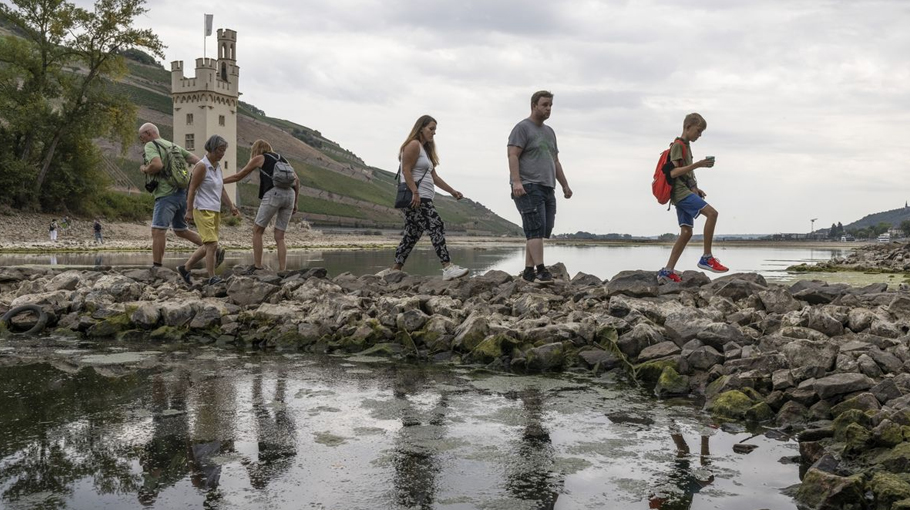From the Rhine to the Tigris, rivers are warnings

You can’t step into the same river twice, the philosopher Heraclitus said in a different context. If he were alive in the era of anthropogenic climate change, he might add that you may no longer even have that river to step into. And even if you do, you might not want to, because its fluids could scorch the skin off your feet.
Just look at Germany this summer. Two of its most symbolic and iconic rivers — the Oder in the east and the Rhine in the west — are crying out in distress.
The Oder, stretches of which mark the Polish-German border, has turned toxic. Dead fish are floating where bathers once swam. The immediate cause remains unclear — Germany and Poland are investigating chemical spills.
But scientists say that drought invariably exacerbates the concentrations of nasty stuff and disrupts the water’s oxygen levels.
The Rhine, meanwhile, has dropped so low that barges are barely able to carry their cargo up and down the river. At a time of other supply shortages — of gas from Russia, grain from Ukraine — everything from coal and steel to chemicals and manufactures is suddenly getting harder to move through Europe’s industrial heartland. The aorta connecting the Alps to the North Sea, and Swiss and German workshops to Dutch ports, is drying up.
The ultimate cause of these symptoms — climate change — sounds inappropriately neutral as a phrase. But global warming — “warming” also sounds so gentle — manifests in many ways, all of them catastrophic. It disturbs the jet and gulf streams that used to reliably circulate our atmosphere and oceans. It thaws permafrost.
It thrusts species into contact with new organisms, causing “zoonotic spillover” — that is, new plagues and pandemics.
To observe climate change
in action, don’t just look
at fires, floods and
heat waves. Also dip a
toe into the streams
Sometimes climate change shows up as heat domes, other times as cold snaps. It causes infernal fires here, Biblical floods there. If it so pleases, it visits several scourges on the same place. A year ago, a tributary of the now-desiccated Rhine deluged entire valleys and towns, killing hundreds and upending the lives of tens of thousands.
There’s something particularly eerie about the way global warming depletes our lakes and rivers. These streams were at one point arteries that nourished entire societies and archived their detritus. Now they’re yielding up those histories. In Italy, the Tiber has fallen low enough to reveal a bridge built by Nero. The Po has brought German ships from World War II to the surface.
In Iraq, a shrinking reservoir along the Tigris has uncovered cuneiform tablets and ceramic pottery from what was a Bronze Age city. In the US, Lake Mead — where the Hoover Dam blocks whatever remains of the Colorado River — is drying into a puddle and displaying everything from sunken boats to dead bodies.
The Rhine, as it bears all, has many tales to tell. It once marked the border region between Roman and Germanic Europe, between a world of wine and olive oil and one of beer and butter.
In the Middle Ages, it was the setting of the Nibelung epic (much later staged by Richard Wagner). To this day, the faithful are searching for the hoard of gold sunk at a secret spot in the Rhine by Hagen, the slayer of Siegfried.
The Romantics of the 19th century discovered the poetic potential of a stream lined by castles and cliffs. At one spot, Lorelei, inspired by Homer’s sirens, was said to sit on a rock, combing her golden hair and singing until rapt sailors met their wet death.
For generations, the river separated France and Germany in mutual enmity — the Prussians who marched to Paris in 1870 were singing “The Watch on the Rhine.” Then it united the two nations as part of a new peace project, nowadays called the European Union.
Today, the Rhine and its tributaries — the Neckar, Main, Ruhr and others — lubricate the vaunted Mittelstand firms at the core of Germany’s manufacturing prowess.
As these rivers, from the Yangtze to the Colorado, slowly evaporate — their water molecules destined to inundate islets or coastlines elsewhere in the world — the emphasis among scientists and policymakers is shifting to “adaptation.” We’ll certainly need a lot of that.
But as we get busy adapting, it’s also worth pausing every now and then to listen to the gurgles of the shrinking streams.
This is no longer Lorelei singing to us. It sounds more like mewling, or even weeping. Maybe it’s the sound of her long dead sailors, trying to send a message.
Andreas Kluth is a Bloomberg Opinion Columnist.
Source: Bloomberg




